This the multi-page printable view of this section. Click here to print.
Leveraging Data Science in the Electric Power Industry
- 1: Overview
- 2: Acquire - Turning Legacy Data into Assets
- 3: Analyze - Gaining Deeper Insights
- 4: Blueprint for Data Science Success
- 5: Case Study - Repeatable Process to Cleanse-Visualize-Analyze
- 6: Increasing Data Science Adoption
- 7: Metadata: Enabling Data Sharing
- 8: Optimizing Discovery Interviews
- 9: Selecting the Right Use Cases
- 10: Store-Optimizing Data Collection
- 11: Visualize: Gaining Insights Faster
1 - Overview
The electric power industry is experiencing a data-driven transformation. Rapid growth in the deployment of sensors, distributed assets, and “intelligent systems” means data is easier to access than ever before. To reap the benefits, utilities will need to master new analytics competencies — including managing and combining multiple sources and types of data, building analytic models, and interpreting findings to make better decisions.
To make it easier for you to start developing new capabilities, EPRI has developed 10 briefs on the theme Leveraging Data Science for Electric Power Industry Transformation. Each paper offers tips and tactical advice to accelerate your progress in data science and machine learning.
The briefs are organized into two series. Series 1 (4 briefs) describes major milestones in the journey toward data science mastery. Series 2 (6 briefs) addresses the Data Science Lifecycle.
Series 1: Key Milestones in the Data Science Journey
 Example heading
Example heading
Learn how to successfully engage stakeholders to guide your data science strategy. Brief includes key steps in the process, a sample interview guide, and a presentation template you can customize and share internally.
 Example heading
Example heading
Drive your data science journey with practical use case scenarios based on your company’s real challenges. The right use cases help test the applicability of concepts and how to tackle them.
 Example heading
Example heading
Leaders in data science have learned that internal knowledge sharing is critical to success. Learn tips on how to implement a digital hub for collaboration to build your capabilities and increase adoption of data science best practices.
 Example heading
Example heading
Improve your progress in machine learning and AI by understanding the technology, tools, and business processes you need to succeed. This Blueprint illustrates functional requirements and how to address them.
Series 2: The Data Science Lifecycle
Series 2 includes six briefs that highlight real business challenges and solutions at different stages in the Data Science Lifecycle. These insights are designed to provide inspiration and ideas for solving similar challenges and address situations that are stage-specific.
 Acquire - Turning Legacy Data into Assets
Acquire - Turning Legacy Data into Assets
In this brief, the challenge is transforming legacy data into useful assets. You’ll learn how to gain incremental value from legacy data by choosing a technology solution to extract, transform, and load data into a format that can be reused.
 Metdata - Enabling Data Sharing
Metdata - Enabling Data Sharing
Collecting metadata is an important subprocess of the Acquire stage, and ideally should occur at the same time you acquire datasets. The challenge here is how to best document details about your data sources to enable sharing data and ensure proper interpretation of results.
 Store - Optimizing Data collection
Store - Optimizing Data collection
The quantity of data, variety of sources and types of data, and ability to make data available to a wider group of users is a challenge to manage. In this brief, we explore how you may need to revise processes and tools.
 Visualize - Gaining Insight Faster
Visualize - Gaining Insight Faster
In this brief, we cover the challenge of accelerating time-to-insight using visualization techniques. Data visualization can be applied to every stage of the Data Science Lifecycle to accomplish tasks more quickly and easily.
 Analyze - Gaining Deeper Insights
Analyze - Gaining Deeper Insights
Most companies build systems to understand “what happened?” and “why did it happen?” This brief explores the challenge in machine learning and AI to answer a new set of questions like “what will happen next?” and “what actions should I take when it does happen?”
 Case Study - Cleanse Visualize, Analyze (new title TBD)
Case Study - Cleanse Visualize, Analyze (new title TBD)
This brief is a case study about the practical reality when an analytics issue doesn’t fit into a single lifecycle stage. The challenge is to create a repeatable process for cleansing data that can be applied to multiple datasets, use data visualization to rapidly identify insights, and create preliminary advanced analytic models.
2 - Acquire - Turning Legacy Data into Assets
To start a data science project, the first step is to identify and assess the available sources of data. We define this as the Acquire stage of the Data Science Lifecycle. Once you identify the data sources, you can use data science tools to efficiently extract, transform, and load (ETL) historical data into a usable format to be used in new ways.
Here’s an example of how it can work… You start the project by selecting a use case (scenario addressing a real business challenge). Suppose your scenario involved a research program with 10+ years of historical data stored in multiple formats (e.g., disks, emails, photos, shared network drives, thumb drives). These materials were generated to address a specific question or research purpose, and had limited value once that question was resolved. However, your use case showed you could gain incremental value from these legacy materials by using new tools to transform and prepare data for analysis and insights.
Quick Tips
- Lead a proof of principle project to understand a body of historical data that could have long term value to your company.
- Start by documenting metadata and create a place to store the data, enabling datasets to be searched and accessed for reuse. (Metadata captures information about datasets, such as the source, owner name, timeframe data was collected, and how the data can be used.)
- Leverage technology to make it easier and more systematic to transform historical data.
Getting Started
Discover
-
Begin with a discovery process to understand what exists, and create an inventory of potential datasets. Note that some data may be stored on external drives or in remote locations.
-
Create an inventory template to help guide the teams in cataloging data more uniformly.
-
Select a use case to test and validate technical solutions for integrating the data and using it.
Design
- Develop business and technical requirements.
- Design the process to extract, transformer, and load legacy data.
- Research and identify tools and technology to make this process scalable and repeatable.
Implement
* Select tools and technologies to perform processes for data extraction,transformation, and loading (ETL). * Identify gaps, such as exception processes, necessary for sensitive information or unusual file formats. * Share access to the newly aggregated data with team members.
With data science tools, importing spreadsheets into a query-able database is effortless. Transformed data changes into a new structure from horizontal rows of data – to vertical columns of data grouped by common variables. You can then use the new structure for data visualization and advanced analytics.
Key Insights
- Many companies have large quantities of data stored in older or obsolete formats If curated and made accessible, this data can be used to address today’s business problems.
- Data science tools and best practices facilitate access to historical datasets and analyses that can enable your organization to generate new insights.
- Machine learning and AI solutions need historical data to be curated and prepared as inputs. Successful data migration and access to older data sources can help advance your machine learning initiatives.
To help you evaluate ETL technology solutions, you can leverage our recommended list of business and technical requirements, and modify it for your organization. You can also use this sample scorecard to facilitate your efforts as your evaluate various ETL solutions.

Conclusion
By selecting a technology solution to extract, transform, and load data, you can develop a process to convert older, unused or forgotten data into assets that have ongoing value. When you implement a small proof of principle project, you help create a repeatable process that can be applied to other datasets. Over time, you can convert a substantial volume of legacy data to help address current and future business challenges.
Supporting Resources
3 - Analyze - Gaining Deeper Insights
How can advanced analytics help you extract new insights from you data?
Most companies have built programs and systems to understand “what happened?” and “why did it happen?” Machine learning and AI leads to new questions like “what will happen next?” and “what actions should I take when this happens?” This brief focuses on the key business challenge for the Analyze stage in the Data Science Lifecycle. Analyze is when you will apply data science tools and techniques to gain deeper insights from your data, and drive further inquiries to help solve business or operational problems.
Objective
Your objective is to explore new data science tools that can be integrated into your company’s toolset to enable advanced analytic modeling. With data science you can use data that may have been underutilized, or perhaps not used at all. You can also generate insights from data that was collected or used for a different purpose For example, many utilities participate in industry benchmarking, and find that reporting on metrics is valuable. With predictive analytics, you might capture even more value by asking a slightly different set of questions.
| Reporting on metrics might start with... | While data science methods might add... |
|---|---|
| How many poles did each company replace? | Why did companies on th east coast replace poles at a rate 25% higher than the west coast? |
| Tallying responses received to a set of survey questions | Using survey responses as a dataset, merging it with external data (e.g., weather data, household demographics) and finding significant correlations beyond the responses. |
| Historical information | Predictive or Prescription modeling that helps to make future decisions |
| Reactive | Proactive |
| Tracks company performance | Shapes company performance |
Using Advanced Analytics
The Analyze stage involves using techniques such as multivariate analysis and predictive analysis, both of which are enhanced with the use of multiple data sources including external data.
-
Get a more sophisticated understanding of the metrics data by applying multivariate analysis.
-
These Statistical techniques help you discover the interrelationships between variables.
Get a more sophisticated understanding of the metrics data by applying multivariate analysis.
These Statistical techniques help you discover the interrelationships between variables.
Get a more sophisticated understanding of the metrics data by applying multivariate analysis.
These Statistical techniques help you discover the interrelationships between variables.
1Properly frame your data science questions
Precision is important because your question has to be supported by the available data. If you were to ask: What is the likelihood that this piece of equipment will fail within the next 7 days? In order to analyze it, you would need a historical record of equipment failures with at least daily frequency. If you’ve only collected that data on a monthly basis, or the asset has never had a failure, the proposed question may not be a good starting point.
2Prepare your data
Once you refine your business or operational question, and matched it with relevant datasets, your focus turns to data preparation. In predictive analytics, it’s common to spend up to 80% of your project time on data preparation. Raw data may have issues with missing values, duplicate records, or inconsistencies. Data from multiple sources may need to be joined to create newly combined records. From these diverse inputs, you may need to derive new variables.
For example, a single parameter may not be predictive, but a calculated ratio using that parameter is. All of this work must take place before your analysis can truly begin. And often, preparing the data is iterative, so you may return to deriving new variables and merging additional data sources as your understanding of the problem evolves.
Translate Your Operational Problem Into Data Questions
Suppose your utility has a class of aging assets, and you want to extend the life of those assets, identify critical equipment to replace, and improve your use of limited resources. To help you refine precise data science questions, it helps to map the operational problems to causes (in data terms), and available datasets that could be used for analysis.
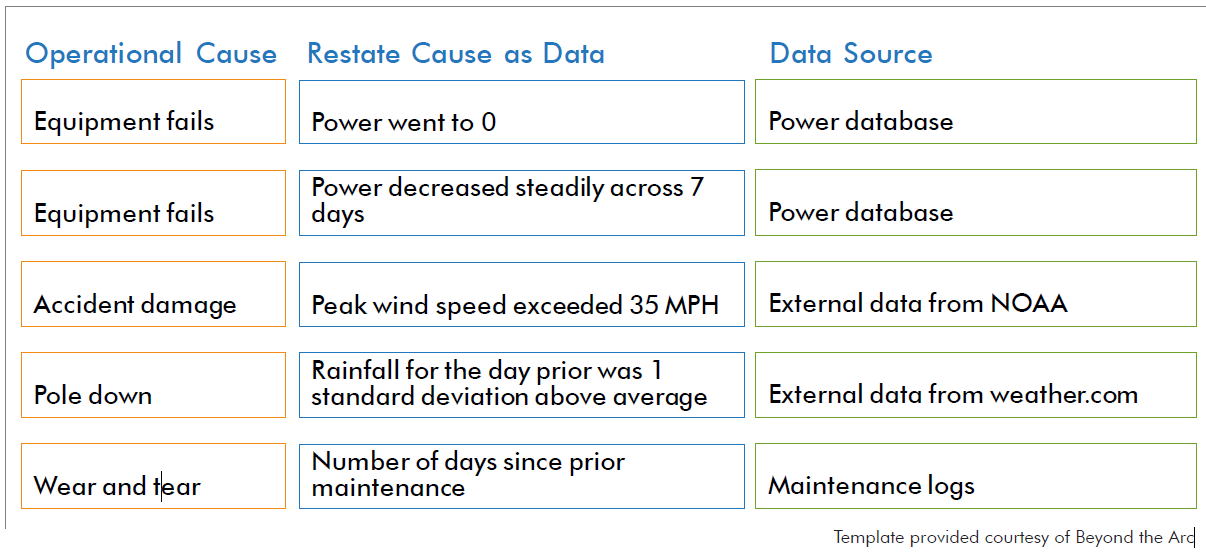
Key Insights
- Advanced data science tools can help identify new patterns in existing data and enable you to determine which factors are potential predictors of future outcomes.
- By integrating multiple data sources, you can gain deeper insights and better understand what correlations have the greatest impact on your metrics.
- Displaying results of analytic models graphically helps you are more quickly identify relevant relationships with the data.
Example: Exploring the Impact of Weather on Electric Pole Replacement
With data science, you can pose different questions about your operations. In this example, we conduct a simple exploration of the relationship between weather and electric power pole replacement.
| We would like to predict the effect that: | Extreme Weather |
| has on: | the frequency of electric pole replacement |
| because if we knew, we would: | Focus on pole inspections and proactive replacements in service territories that have consistently bad weather |
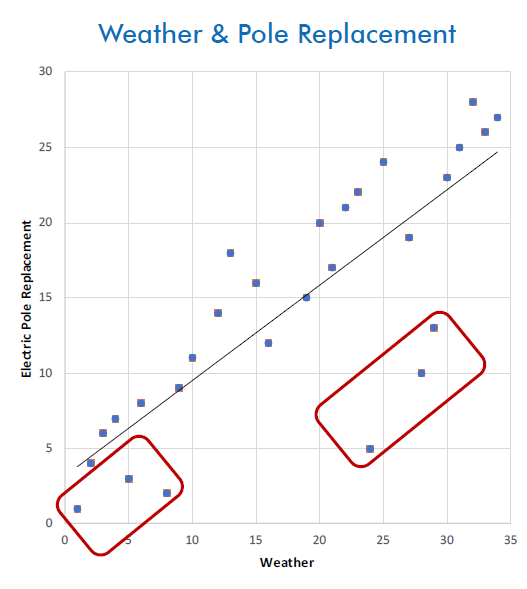
In this scenario, we needed a way to compare companies. Instead of using raw data, like inches of snowfall or number of poles replaced, we calculated rankings for the companies. We identified which companies replaced the most poles, and which had the highest number of extreme weather events.
In visualizing performance from this ranked perspective, Company A and Company B looked more similar, even though Company A replaced many more poles. This ranking method also helped to identify groups of companies that did not fit the generalized patterns.
Data visualization like this can help point you toward datasets that might be valuable in a predictive model. You might want to acquire data on pole materials, construction, soil conditions, prolonged vs. acute weather events, and much more. With data science, you can evaluate potentially thousands of inputs, and assess the degree to which each one contributes to an accurate prediction.
Plan Before You Analyze
This planning template is a handy “quick start” tool to help you identify the key elements you will need for an analytics project. If you’re still exploring which data science solutions to use, take advantage of the Analytics Technology Evaluation Scorecard.
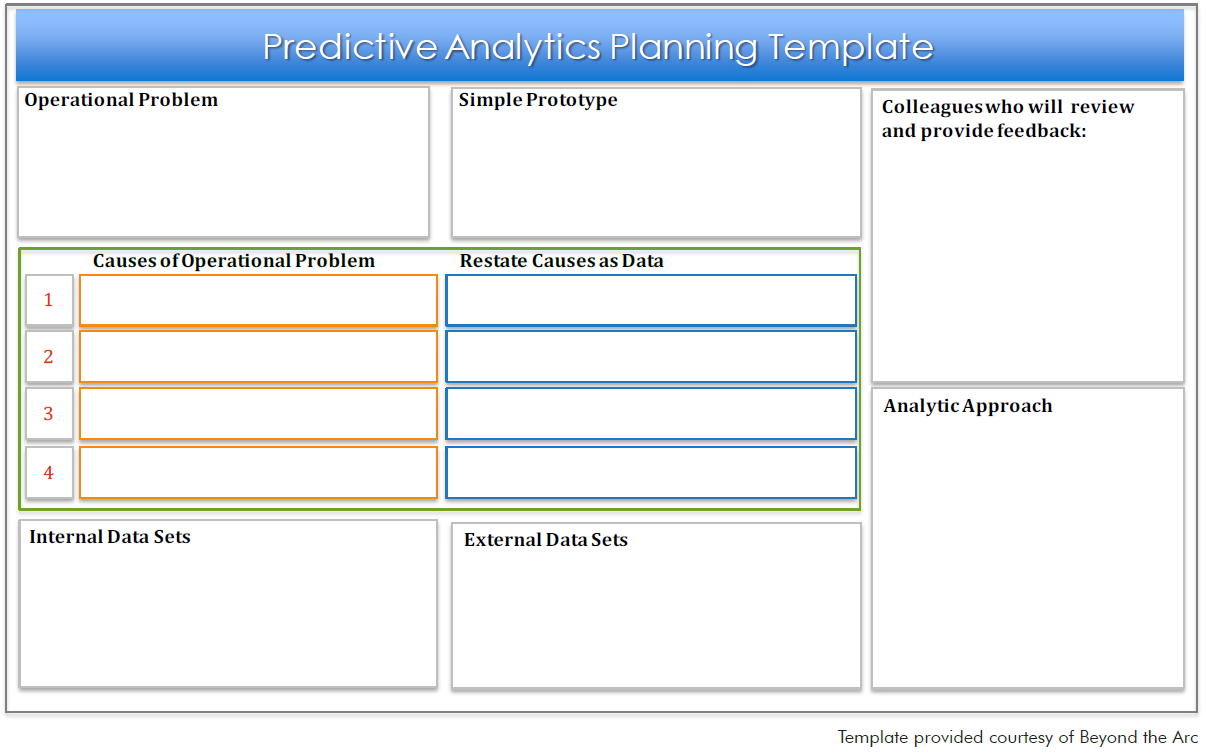
Quick Tips
- Demonstrate the benefits of data science on projects that people in your organization can understand and relate to.
- Choose technologies with a graphical user interface and require minimal or no programming skills. The easier the technology is to learn and apply, the more likely your staff will use it.
- Implement a proof of principle and explore various analytic technology solutions. This practical experience will help you determine which ones will best meet you company’s needs.
Conclusion
Supporting Resources
- Predictive Analytics Planning Template (PPT)
- Analytics Technology Evaluation Scorecard (Excel)
4 - Blueprint for Data Science Success
To encourage and accelerate data science capabilities, companies need an integrated system and supporting processes that support this goal. It starts with creating a framework for building and evolving your data science, machine learning and AI initiatives. To help you get started, EPRI designed a System Blueprint for Data Science (system architecture diagram). The Blueprint defines the essential elements and illustrates requirements of an integrated system. You can use it as a template, and modify and enhance elements to meet your specific needs and reflect your company’s practices and corporate policies.
This Blueprint is also a valuable tool to help stakeholders and decision-makers understand, validate, and communicate data science needs that enable predictive analytics and machine learning. For companies with more mature capabilities, the diagram can help them identify potential gaps in existing processes, procedures, technologies, or skills.
Here’s a snapshot of the Blueprint, which identifies the main components involved in the stages of the Data Science Lifecycle — Acquire, Store, Cleanse, Visualize, and Analyze.
Getting the Most Out of the Blueprint
Your objective is to design an approach that will help your company speed the adoption of data science best practices, processes, tools, and technology. To guide your planning, this Blueprint helps you understand the stages of the Data Science Lifecycle. The diagram shows the elements you’ll need to optimize that will lead to capturing more actionable insights from data and analytics.
Data Sources
Not only do you want to access all the data your teams may have already individually collected, but new data sources are becoming available daily from public sources such as government agencies, device manufacturers, and internet users through crowd sourcing. This Blueprint lists some examples of internal and external data sources, but the list is much longer and constantly changing.
Delivery & Extraction
This component involves tools to extract and consolidate data from primary databases in bulk or batch. The tools offer an efficient and systematic way to pull in volumes of data. Typically, the data travels to a staging environment for virus and malware screening, before moving into storage.
Data Cleansing
Cleansing is a critical first step before conducting any data mining or advanced analytics with datasets. Some of the activities include anonymizing data (e.g., removing confidential, identifiable customer information), normalizing data into the same unit of measure or same time of day, removing duplicates, and understanding the magnitude and significance of missing values.
Quick Tips
-
Use the blueprint to understand how all the components fit into the Data Science Lifecycle.
-
Determine which of the nine blueprint components your company has in place now, and which ones you need to add or enhance in the future.
-
Assess the maturity of your company’s data science capabilities (usually obtained through Discovery Interviews) to ensure your implementation plan expands on the current skills.
Tip: See our brief on Optimizing Discover Interviews ▷
Virtual Data Lake
This Blueprint assumes all data owners and managers will store their data “in place” with no change to its current location. The virtual data lake indexes all datasets, making them searchable and available for use by others within the company. Permission for use is determined and granted by the data owner. Some organizations may opt to develop data lakes, data warehouses, data marts, or other architectures. Those strategies are compatible with the overall approach outlined in the Blueprint.
Data Science Tools
The tools include open source products like Python, R, as well as proprietary platforms that are available from a number of vendors. These tools help data scientists discover predictive information that will help them create analytic models and successfully get to insights.
Compute Layer & Virtual Machines
The compute layer refers to the data processing power required to churn through volumes of data for visualization and advanced analytics. Processor-intensive work no longer requires physical machines or super computers. Today, companies can scale up with virtual machines (often cloud-based) to meet their changing needs for processing power.
Data Science Workspace
This is a virtual sandbox for creating data visualizations and developing analytic models. For people working in data science, visualize and analyze are the most rewarding stages of the lifecycle because they lead to new insights.
Metadata & Data Management
Metadata refers to capturing descriptive information about datasets such as data source, data owner, and timeframe that data was collected. Metadata is critical to enable data sharing as it provides the information to create an index to make datasets searchable.
Data management is the organization of datasets and administration of permissions to review, edit, and use data in the virtual data lake.
Security & Governance
Processes and rules for governance are needed to screen, evaluate, and index datasets before they are stored in the virtual data lake. Governance helps to ensure data lake contents remain relevant and useful. Security protocols are needed to design the user permissions for who can read, edit, and use the data.
Key Insights
-
To communicate with stakeholders, it’s helpful to use a system diagram like this Blueprint because it shows the key components and their relationships to one another.
-
For each major section of the Blueprint, consider developing proof of principle projects to demonstrate how technology can meet identified needs and solve real business challenges.
Supporting Resources
5 - Case Study - Repeatable Process to Cleanse-Visualize-Analyze
Smart sensors are transforming how we think about data – enabling utilities to gain insights about customer behavior such as energy use by appliance, lighting, heating unit, and air conditioning system. However, the ecosystem of intelligent devices is rapidly expanding, with differing protocols and proprietary data formats, where the same event can be measured in different ways. The sheer volume of data and lack of standards can create a roadblock for many energy companies seeking to make progress toward machine learning and AI.
This brief presents a repeatable process to cleanse, visualize, and analyze large volumes of customer data, which you can follow like a playbook. The exact data preparation and analysis steps may vary based on the dataset, but this approach will help you save time and avoid common pitfalls.
This infographic shows the data science workflows end-to-end. What becomes immediately clear is that analysis, and ultimately machine learning, is dependent on successful completion of many prerequisites.

About the End-to-End Process (Infographic)
 Ingest-to-Store
Ingest-to-Store
The infographic shows several types of smart devices that are collecting energy usage data (new devices enter the marketplace regularly), and how the data is moved into storage. The storage solution can be multifaceted with cloud, on-premise, and hybrid.
 Cleanse & Data Prep
Cleanse & Data Prep
The data is pulled together and aggregated to become big data from thousands of households and individual devices, and potentially tens of millions of data points. Given the massive amounts of data collected, you may find it easier to get started with smaller datasets to focus on data understanding, cleansing, and normalizing.
 Visualize-to-Analyze
Visualize-to-Analyze
Using visualization techniques can help you get to insights more rapidly (such as load forecasts and rate influence by customer segments). It can also inform you on how best to start building analytic models. Finally, once you understand what the data means, you can create advanced analytic models to help predict load changes and impacts to demand.
Key Insights
- The value of time series data (like the continuous flow of data from sensors) can more easily be extracted when you apply a streamlined, repeatable process.
- Selecting the right visualization to present your findings helps tell the story and highlight patterns. Data visualization enable you to move to the analyze stage more effectively and select the most appropriate analytic models.
- Consider incorporating external data (e.g., weather, housing type, demographic) with your customer sensor data to enhance your analyses and gain deeper insights.
- To make progress toward machine learning and AI, you will need to create a pipeline that links all of the necessary tasks and workflows.
Create a Repeatable Data Cleansing Process
The proliferation of intelligent devices for consumers is enabling companies to collect customer-specific data at higher speeds and in larger amounts. That means repeatable processes for data cleansing are especially important. A key challenge is understanding how to cleanse and integrate that data efficiently. Integrating the data, often from multiple vendors, creates opportunities to understand end-use load profiles with much greater resolution, and apply new capabilities to assess load performance characteristics.
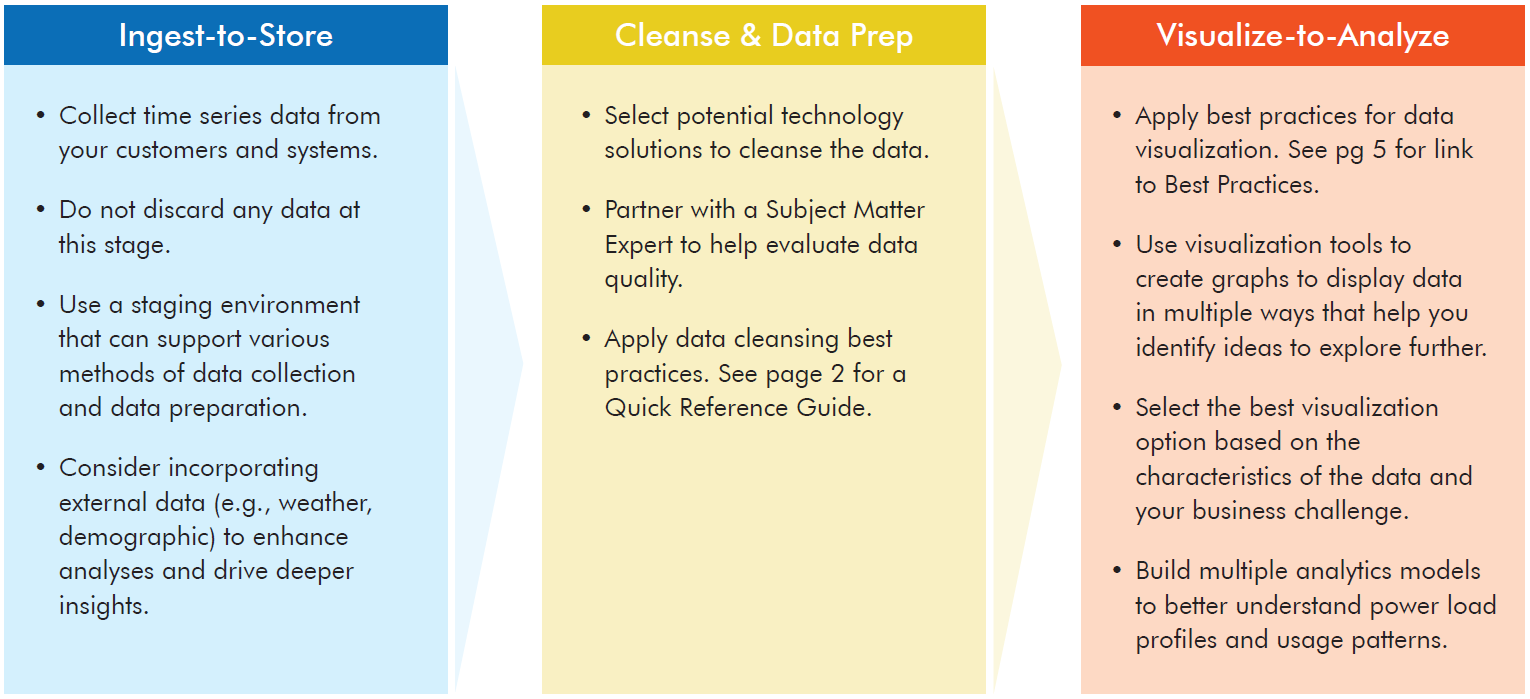
Here are some lessons learned to derive insights from large volumes of time series data. While sensors measure a multitude of specific conditions that would be helpful to energy companies, knowing how to get started can be a challenge.

Conclusion
This brief provides standardized processes for you to follow when working with sensor data. Customers are continuing to adopt new smart devices to measure and control their homes and buildings, which means the volume of data will grow exponentially. Now is the time to begin to explore, understand and derive insights from this data and use it to transform customer relationship management, demand planning, and to build load profiles. Your work in these areas can lay the foundation for increasingly sophisticated analysis and breakthroughs.
Quick Tips
- Start with a modest portfolio of time series data to use for testing and learning. Data cleansing and preparation tasks require significant investment in time to curate and normalize.
- Expect to see gaps in your data records as a normal occurrence. As time series data changes by day, week, month, and year – gaps can occur due to faulty readings, network connectivity, or other factors.
- Integrate multiple data sets to create preliminary models as a way to understand and predict customer energy demand.
- Build several analytic models to help characterize and understand end-use load profiles. Complex energy usage scenarios may require an ensemble of multiple models contributing to predictions.
6 - Increasing Data Science Adoption
To expedite the adoption of data science and promote the business value of analytics, it can be highly effective to develop a knowledge-sharing website. A Knowledge Resource Center website is often easy to build and scale, and serves as a “digital hub” for people across the organization to access data science best practices and expertise, spark collaboration, and explore tools and resources.
A Knowledge Resource Center site supports data science adoption by enabling rapid information sharing and connecting people with the resources and colleagues they need to be successful. As your company continues to aggregate valuable data, code and models, key learnings, and more, this digital hub increases in value. The site can also be helpful for staff development, supporting different levels of knowledge and skills.
Getting Started on your Knowledge Resource Center
Your objective is to create a knowledge sharing “digital hub” that can be implemented as a prototype within 4-6 months, and is scalable to an entire company. A core design requirement is that the solution will be easily accessible to everyone within the organization, and provide learning paths for users with varying levels of experience.
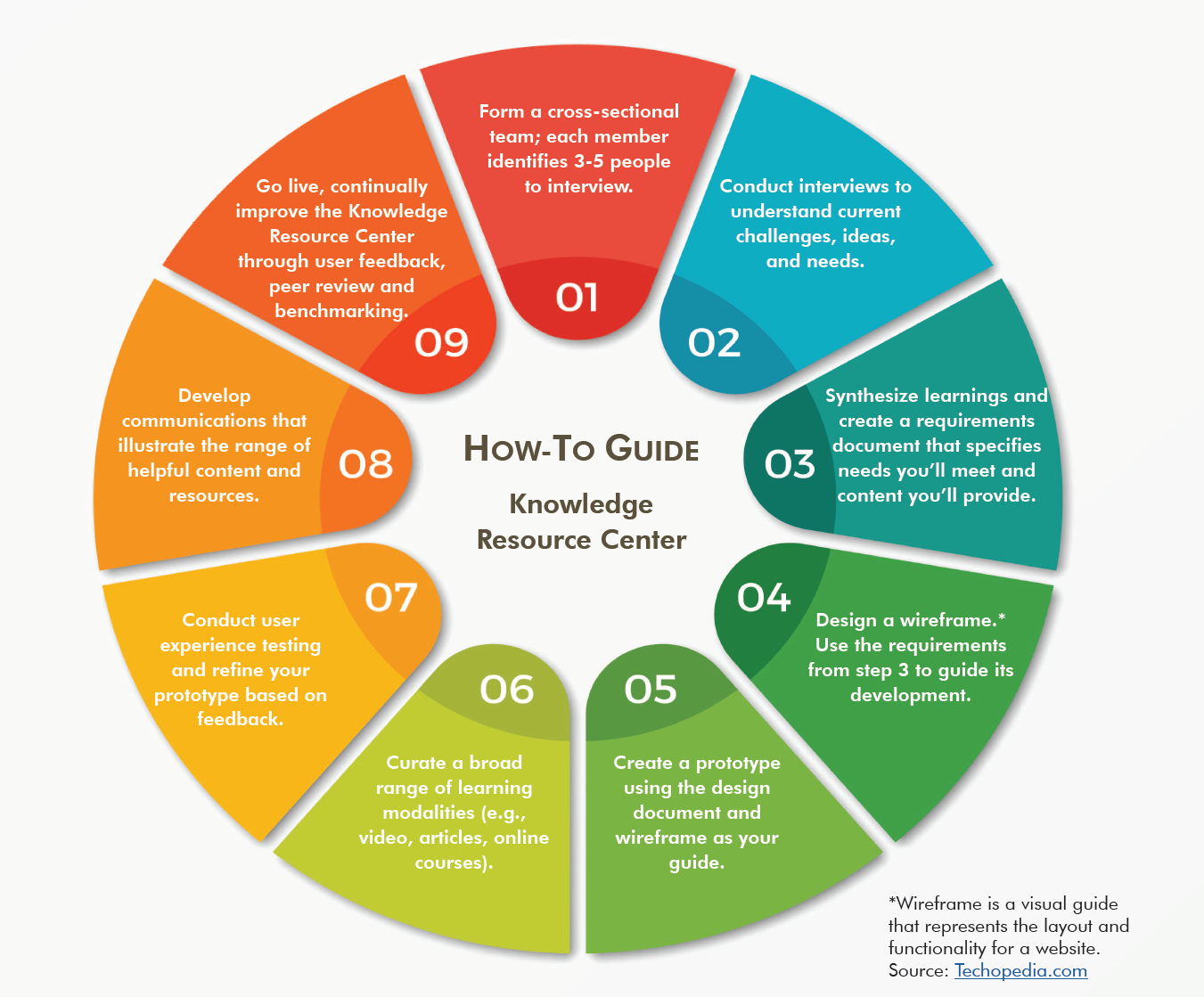
Key Considerations for your Knowledge Resource Center
User-focused
- Users are at the heart of the Knowledge Resource Center. A key design principle is to understand user needs (current and future) and define requirements that address them.
- User needs vary greatly based on their current level of data science familiarity and expertise.
- Consider developing personas (profiles that represent “typical users”), use cases (scenarios that envision how users may want to use the site), and user journey maps (paths that users may follow to accomplish certain tasks on the site).
- The Knowledge Resource Center is an evolving entity that should grow and adapt based on users’ changing needs and feedback.
Fast Prototype
- Plan the Knowledge Resource Center to be an evolving resource. Iterate and improve!
- Site design, page layouts, and an intranet hosting platform should all enable you to easily add and update content and functionality.
- Consider content publishing options that do not require knowledge of HTML or complex coding.
Curated Content
- Link to internal and external content, including articles, video, shared code repositories, etc.
- List members of the data science community across the organization.
- Refresh content, curate new content, and regularly test links and delete dead links.
- Consider allowing users to contribute content.
Key Insights
- A Knowledge Resource Center accelerates data science adoption by connecting people with information, tools, resources, and internal experts (colleagues who can mentor and guide).
- Learning paths address different skill levels (beginner, intermediate, advanced) and roles (e.g., program managers, supervisors, IT, Legal, HR, Supply Chain).
- Leadership by a cross-functional project team can more efficiently develop successful solutions and implement them.
Quick Tips
To help you get started building a Knowledge Resource Center:
- Use cross-functional teams to create buy-in and address the needs of all stakeholders.
- Keep a user-focused journey in mind to enhance the experience and gain support from all functional areas.
- Accelerate implementation by rolling out fast prototypes, rather than waiting until you have the “perfect” solution.
- Continue to enhance the Knowledge Resource Center’s offerings based on feedback from users, peer review, and newly curated content.
Conclusions
A well-designed Knowledge Resource Center is an excellent way to expedite the adoption of data science. It’s important that the planning, building, and refining process is a collaborative effort across all departments and functional teams, and includes input from people with different levels of experience. Engaging the needs and interests of all stakeholders helps you gain a broad audience and maximize the benefit of this user community.
7 - Metadata: Enabling Data Sharing
Metadata is descriptive information about data such as data source, location, owner, field names and so on. With advanced analytics, the definition of what constitutes data is greatly expanded. In addition to databases, your data includes archives of photos and video, diagnostic test results, sensor readings, log files, documents, spreadsheets, and more.
Given this expanded definition, data can be found almost anywhere and data owners distributed throughout your company. A metadata project will help you understand what data is available to be inventoried and shared with the rest of the organization. A logical first step is to take an inventory of datasets and collect standard information about them in an electronic catalog. In the example below, all of the fields are searchable and the record provides users with enough details to search, retrieve, and evaluate the dataset.
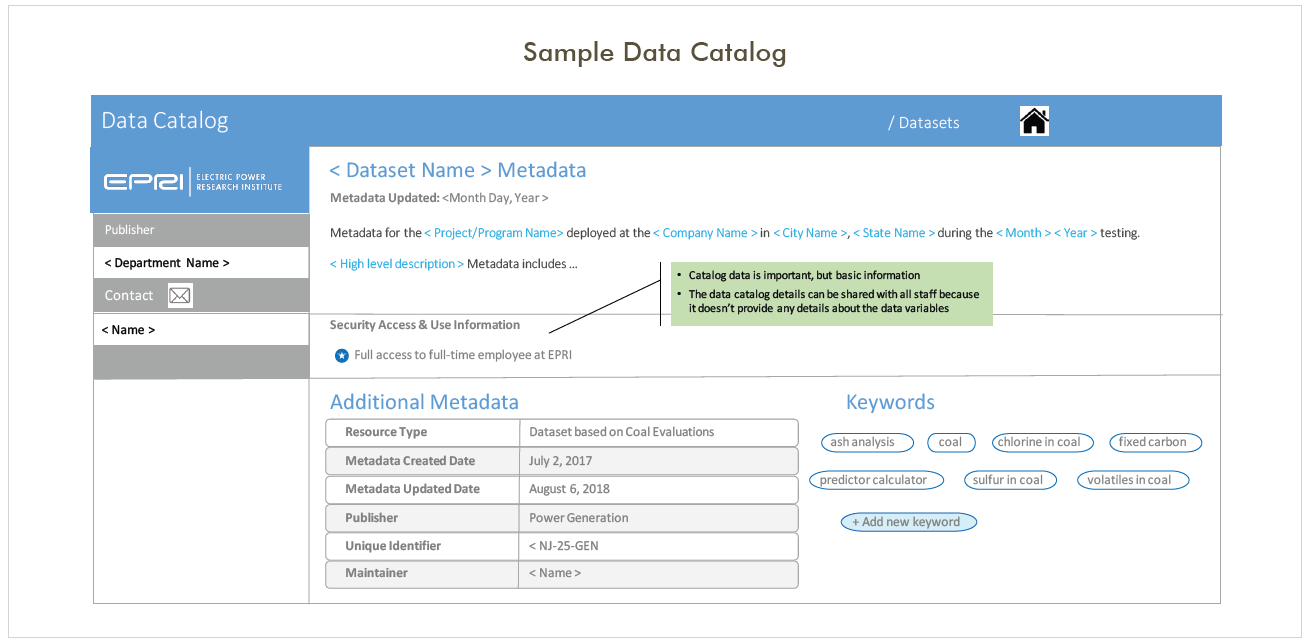
Objective
Your objective is to lead the development of a metadata management strategy to facilitate the sharing of datasets, create new opportunities for collaboration, and reduce redundancy in data collection. Typically, there are three stages in metadata content development: Data Catalog, Data Definitions, and User Annotations.
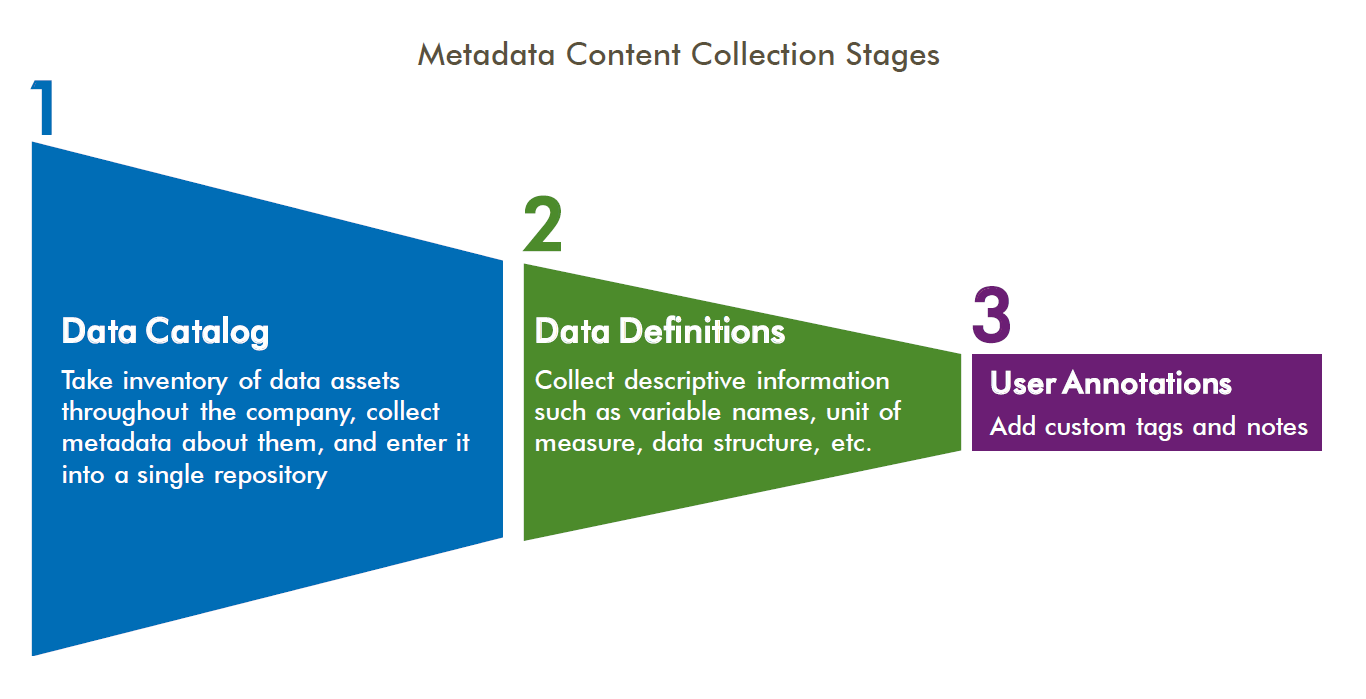
Key Insights
- A systematic approach to collecting and storing information about datasets helps ensure data becomes more accessible for reuse, and delivers ongoing value as an asset.
- A metadata catalog reduces time spent searching for data and allows more time for data preparation, visualization and analysis.
Collecting Metadata
In your data catalog, the metadata (descriptive details) will enable others to discover and view the data. These six types of questions can guide you on what to include in the catalog design.
-
Who created the data?
-
Who owns the data?
-
Who will maintain it?
-
Who is using the data?
-
What is the purpose of the data?
-
What is the content of the data?
-
What is the security level?
-
When was the data created?
-
When was is last updated?
-
Is there a date when the data becomes invalid?
-
Where is the data stored?
-
Where did the data come from?
-
Why was the data created?
-
How is the data formatted?
-
How many databases store this data?
-
How can users gain access to the data?
Organizing Metadata
Here is an example of a metadata schema for a data catalog, which shows how the descriptive information can be organized.
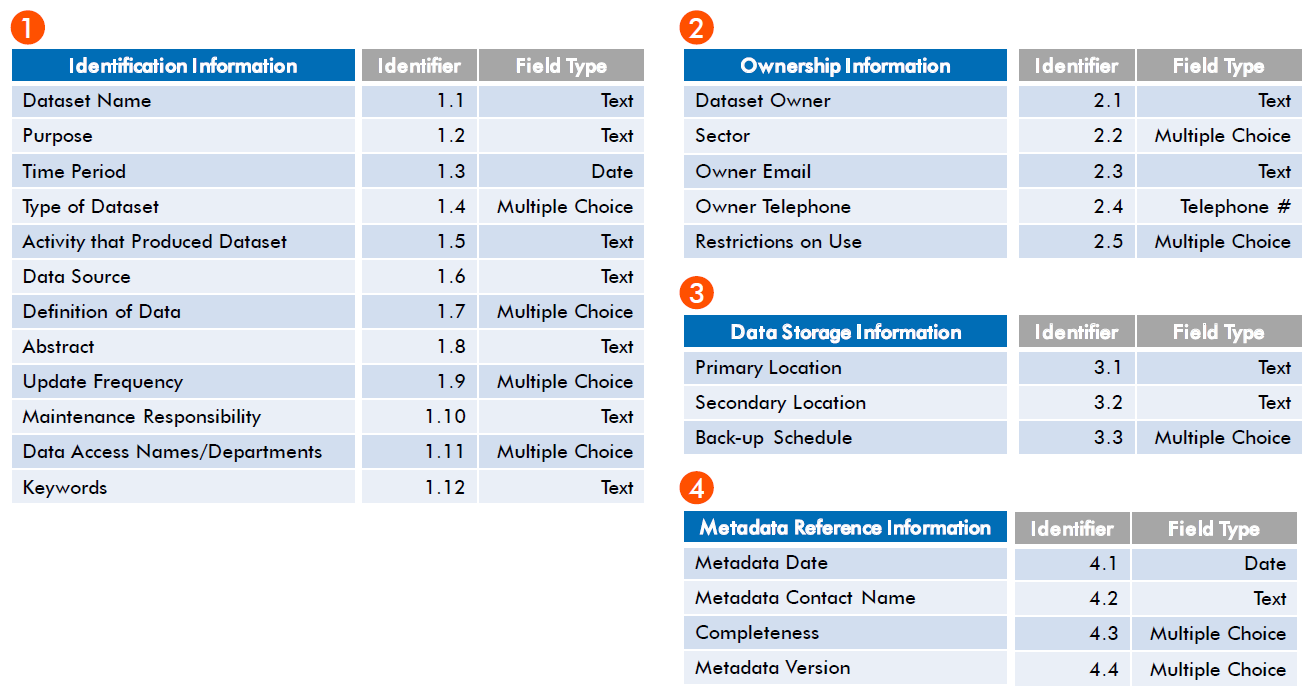
Quick Tips
- Start with a proof of principle project that takes a small, manageable set of data sources to explore and test metadata approaches and technical solutions. You’ll need to test and re-test to find a system, process, and storage solution that will meet your company’s needs.
- Use a cross-functional team to lead metadata planning and management. Their expertise will help ensure the data descriptions are valid and organizationally correct, which helps facilitate data sharing and consistency.
- Select a metadata storage solution that can be accessed by most people in the company and uses a format that will last over time. As you identify options, consider mature formats supported by several vendors, or open source alternatives.
Conclusion
Metadata collection and management can give you significant insights into the variety and types of datasets available within your organization. You can also save time and resources in the long run. Your teams benefit by sharing reliable datasets and avoiding duplication.
When your solution is in place, you’ll make it easier for people to design and manage new analytic models that generate actionable insights to solve business challenges.
8 - Optimizing Discovery Interviews
The first phase of a data science initiative is to gain understanding about issues your stakeholders are facing — and you do that through Discovery Interviews. These interviews lay the groundwork and provide direction for the strategies and tactics you’ll need to use data effectively. With Discovery Interviews, you’ll come to understand your organization’s current state, as well as gaps and needs related to data science and machine learning, such as maturity, readiness, and ways to address the path forward.
Discovery is a critical first step before you design a data science solution. It helps ensure your solution fits the needs of your organization, now and in the future.
Key Insights
- Your goal is to identify problems that need solving, current analytic tools and technologies in use, existing processes, team capabilities and skill gaps, data sources, and more.
- Discover Interviews help you focus efficiently on organizational needs and challenges.
- Cross-functional teams are effective at leading the process and conducting interviews as they have a broad understanding of the organization and can help generate actionable outcomes.
- Results of Discovery Interviews will help guide the steps you’ll take to deploy data science in a way that best meets the specific needs of your company.
Keys to Succesful Discovery
Your objective is to understand and document your company’s unique needs and determine where your organization is on the data science maturity curve. Insights gained from Discovery Interviews will help you identify “use cases” (scenarios based on your organization’s real challenges), explore technology solutions that meet your company’s needs, and design a blueprint for moving forward with data science and machine learning.
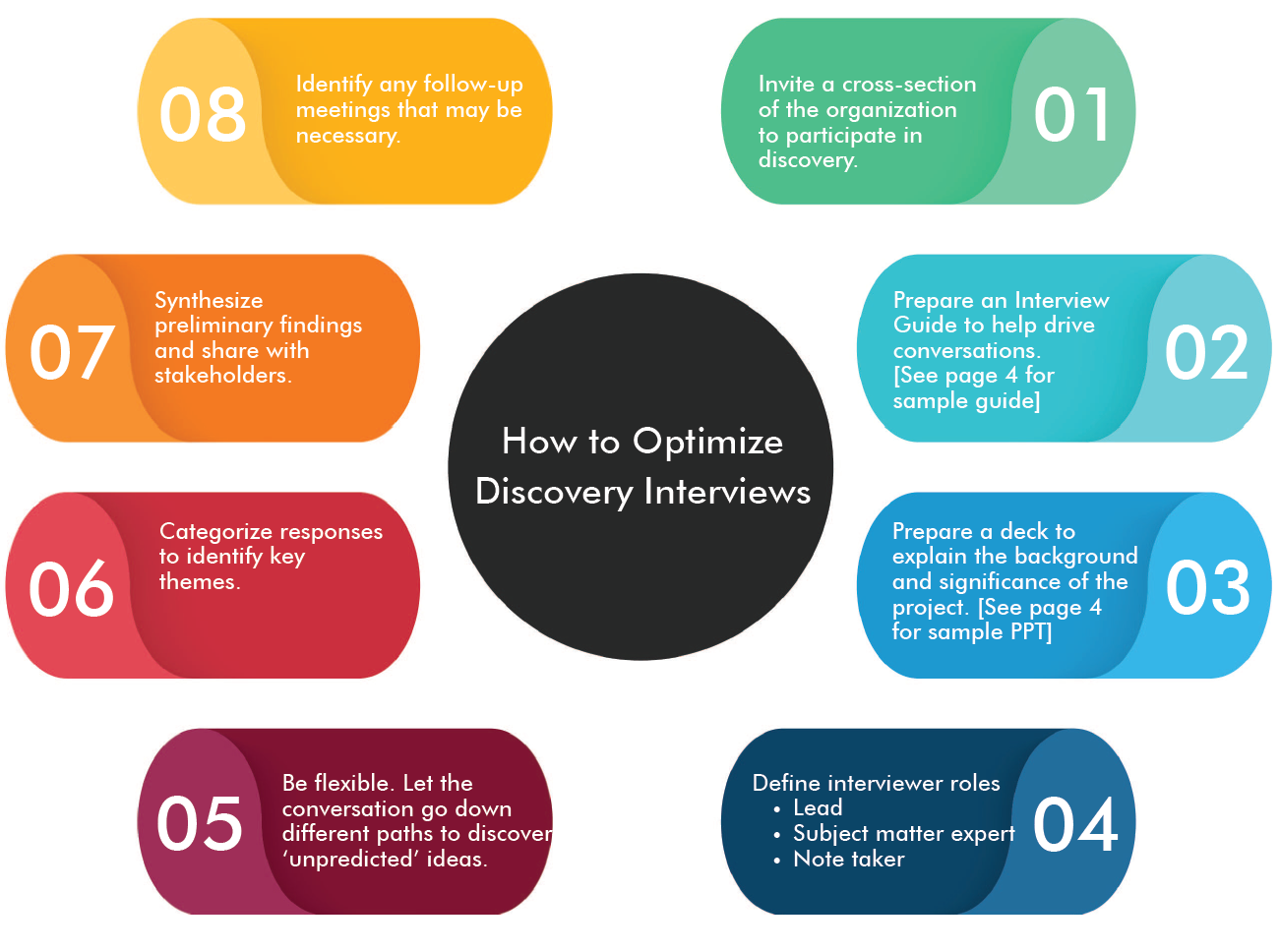
Building Buy-In with Stakeholders
By sharing more information with your interviewees early in the process, you’ll get more out of the Discovery Interviews. For example, create a presentation about your data science initiative and the value that advanced analytics can bring to the organization.
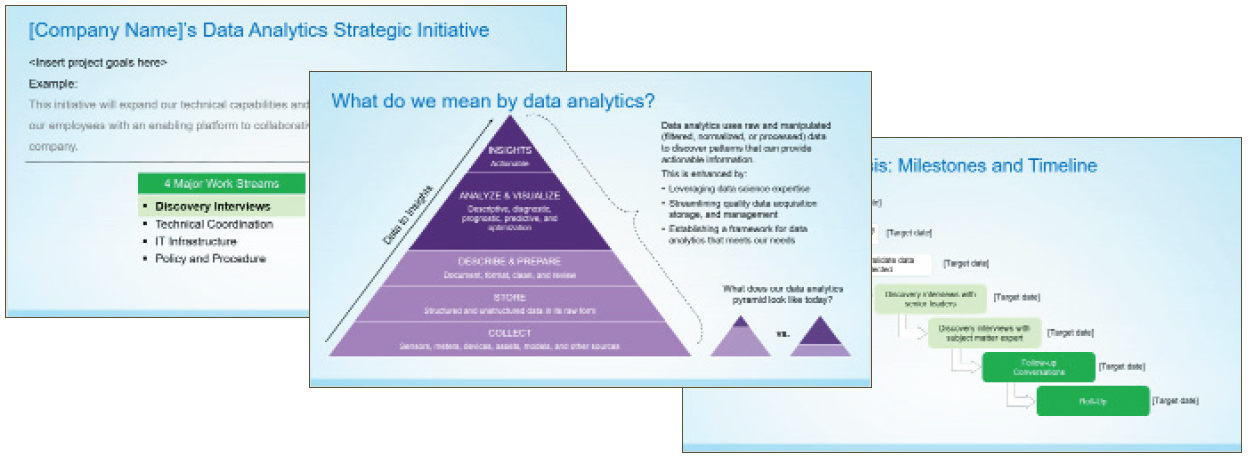
Key Insights
- Recruit an executive sponsor to help communicate the importance of participating in the Discovery Interview process.
- Have a consistent interview team. It will save time in sharing insights from one interview to the next, and enable the team to compare and contrast responses.
- Focus on wins. Communicate how this project will benefit the interviewees, “what’s in it for them.”
- Interview a diverse group of stakeholders. Include senior leaders that represent a cross-section of the organization, technical subject matter experts, and functional leaders (e.g., HR, Legal).
Conclusion
By following the 8 steps for optimizing Discovery Interviews (page 2), you can uncover specific business questions from across your organization that can be addressed through data science. Creating a summary of all your interviews will help you to understand and document:
- Current state – You’ll discover how to (or how not to) handle all the data flowing into and through your organization. You’ll also learn what your team members need to be able to more easily harness the opportunities the data offers.
- Specific challenges – The discovery process can reveal gaps in technical and business understanding, infrastructure, policies and procedures, skills and capabilities. It can also shed light on employee awareness (or lack of) about the potential of data analytics techniques to enhance their work.
- Solution opportunities – The data science solutions you build must fit your organization’s specific needs. Ideas shared by the interviewees and themes found during the interview synthesis help drive the next steps of the project – including development of use cases (scenarios based on real challenges) and selection of technology.
As your Discovery Interviews help you better understand the organizational challenges to be solved with data science, you build a foundation for the path forward. This process also enables you to increase engagement across the company, and motivate team members to enhance their data literacy and recognize the powerful business impact of data science, machine learning, and AI.
9 - Selecting the Right Use Cases
To get the most value from your data science and machine learning efforts and capture more actionable insights, you will need to identify scenarios based on your real business challenges. This approach will help you gain deep insights through analytics and help ensure they have a meaningful impact. We call these scenarios use cases, and they guide your team’s search for analytics solutions. Anchored by this real-world focus, you can uncover and validate business and technical requirements.
Use cases also help your organization understand the value of specific data science processes. As you explore approaches and experiment with tools and techniques, use case owners can play a key role in evaluating the shortlist of possible data science solutions.
Key steps for selecting use cases
It’s important to create a consistent process to find and evaluate use cases, so you target what’s most helpful. A best practice process has three components: identifying scoring criteria, collecting and evaluating submitted ideas, and selecting the final use cases for execution.
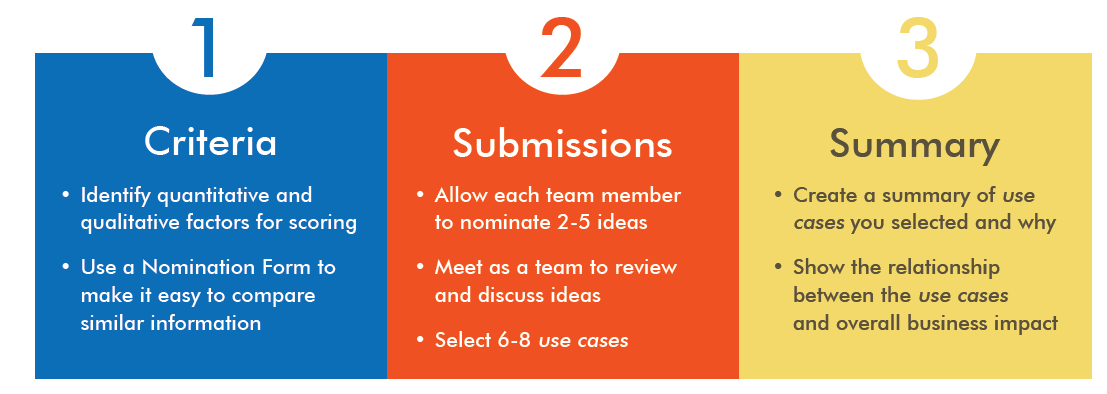
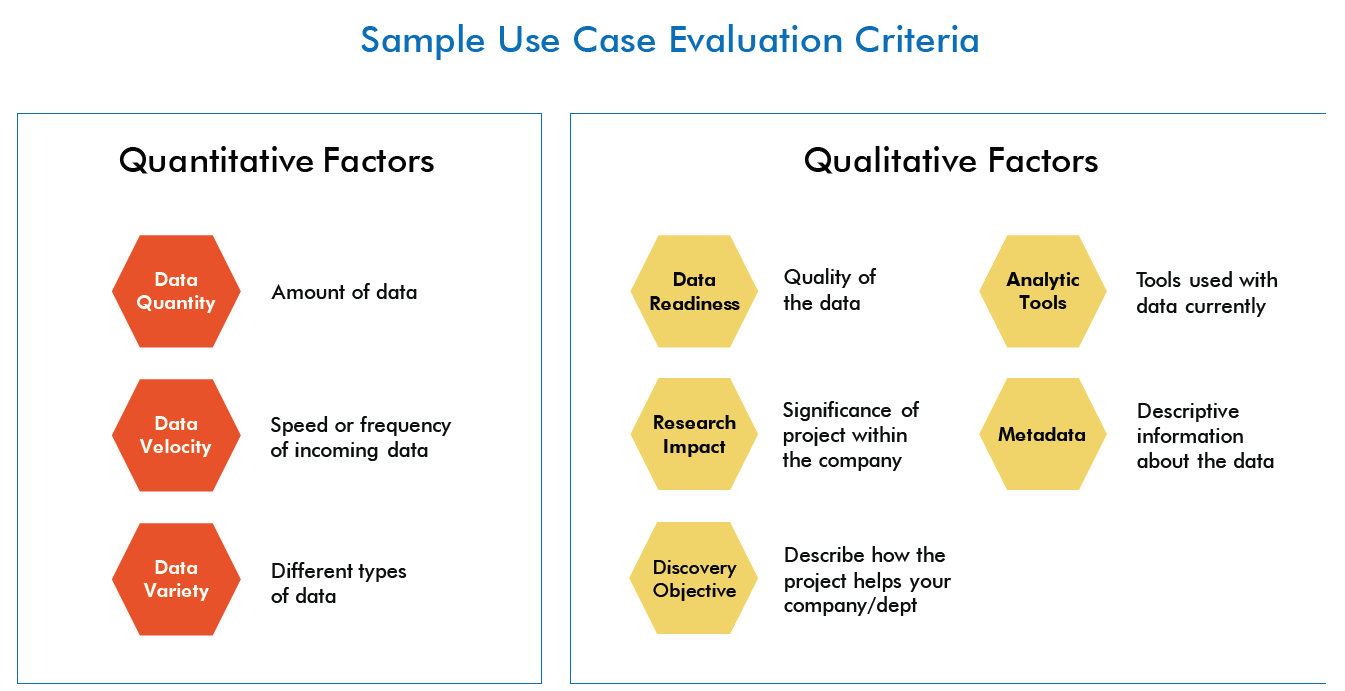
- Use the criteria to evaluate the business challenges and measure them along these factors.
- Choose 6-8 scenarios to demonstrate practical solutions for a variety of issues affecting several different stakeholders.
Key Insights
- Cast a wide net to collect and consider a diverse set of use cases that represent key stakeholders throughout the company.
- Establish selection criteria that are both quantitative; agree on and communicate the criteria before ideas are submitted.
- Select actionable use cases that can help you demonstrate new ways of thinking about business problems and unlock answers by applying data science and analytics.
- Narrow and focus each scenario so that it addresses a specific business question, and can be tackled in a limited timeframe.
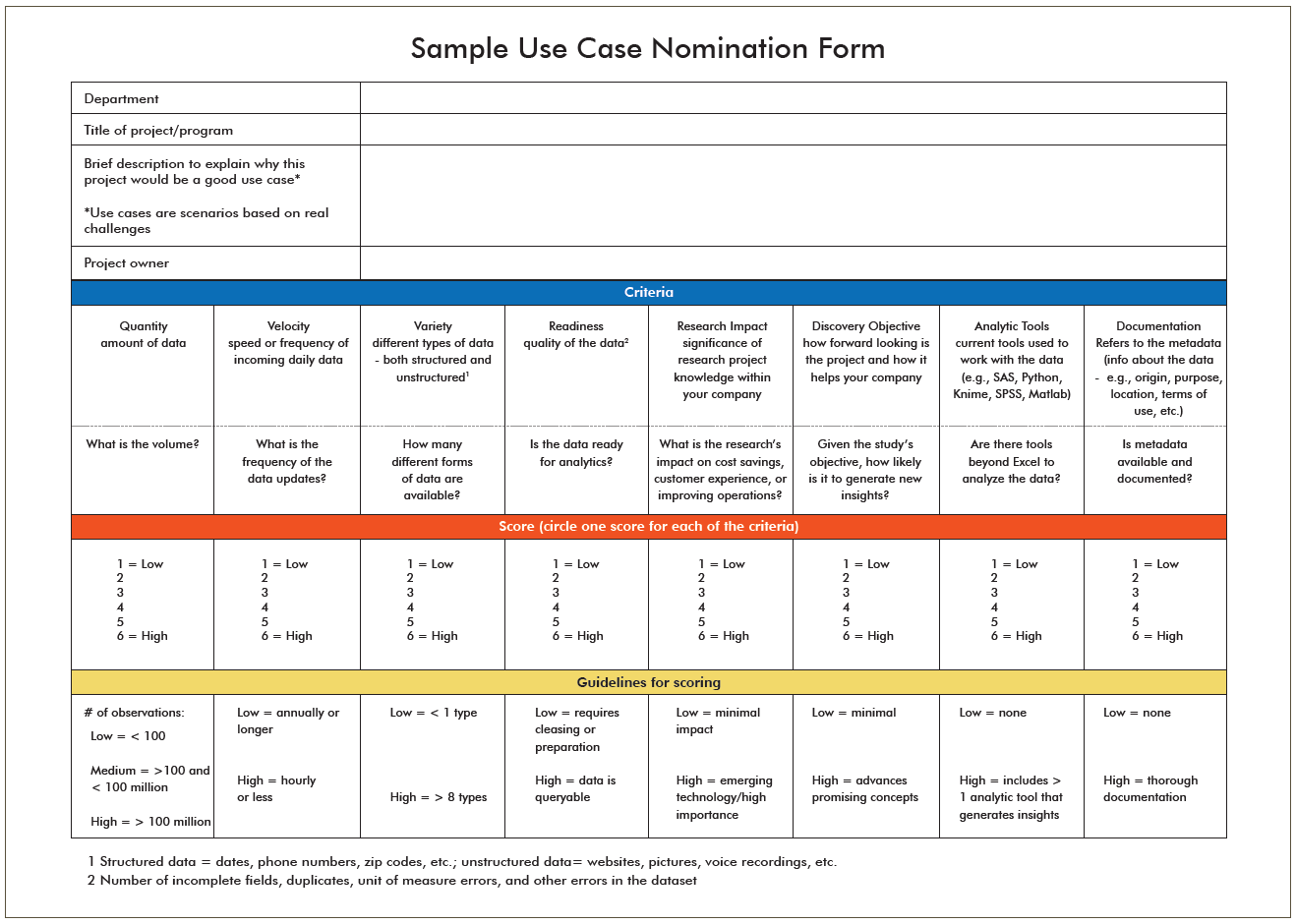
Quick Tips
- Choose 6-8 use cases to demonstrate practical analytics solutions for a variety of issues affecting different stakeholders across your organization.
- Select scenarios with a limited scope that can be completed within 2-3 months.
- Ensure selected use cases showcase showcase the big picture of how to use data smartly.
Conclusion
Use cases are an important part of a data science implementation because they help your organization understand the value of specific technical solutions and data science processes. By illustrating an array of real and current challenges, these scenarios help to engage stakeholders throughout the company, and build buy-in to support the overall analytics project and its outcomes.
10 - Store-Optimizing Data Collection
Many power companies are deploying new technology and sensors to capture entirely new sets of data that can help improve operational efficiency, safety, and reliability. The real payoff is the ability to combine this new information with existing data found throughout your company – to discover new insights and anticipate future conditions. To ensure you can use this new data for advanced analytics such as predictive or prescriptive modeling, you may need to revisit your data storage strategy.
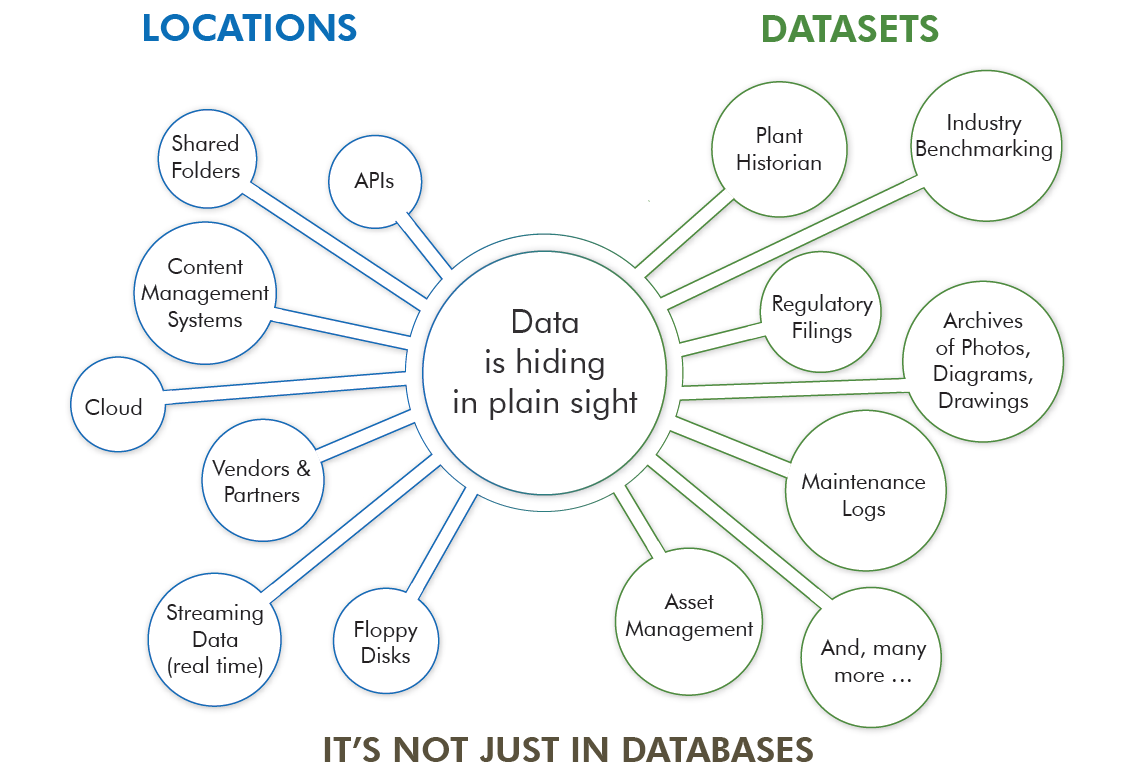
Objective
In this brief, we introduce you to ways to think about data collection to ensure you capture and store relevant data that can be used more effectively for advanced analytics.
8 Questions to help you Optimize Data Collection
Quick Tips
- Scale data storage incrementally on an as-needed basis. Many low cast storage options such as cloud and virtual computing make it easier to increase capacity while minimizing upfront capital costs.
- Store data closest to the source For data collected from new technology such as sensors, initially evaluate and prepare data locally before moving it to longer term storage. This may save you from moving large quantities of data unnecessarily.
Review Data Collection Early & Often
As you work with new data sources from sensors, AMI, and smart systems it is important to check how data is being captured and stored early in the collection process. It helps you determine if you need to make adjustments to what data is being collected (types of data and various fields). You’ll want to identify early on if you need more or different information, and if you’re capturing the right data to support testing your hypotheses with analytics.
As an example, consider the preliminary data structure below, extracted from monitoring equipment. The Data IDs represent sensors at different locations throughout a plant, each of which typically collects different data. However, here we see two Data IDs capturing parameter A data, and two with parameter H data. This is unexpected. So you might question, is there more than one measurement location for each parameter? Or, is there an error in data collection and storage processes that records two readings?

New Uses for your Existing Data
To develop analyses using machine learning, you will likely be using data from operational systems that were originally collected for very different purposes. Your storage capacity needs may increase sharply to retain granular data that your systems currently either compress or discard. Not only will you save more data, but you will want to replicate data from operational systems so that it can be used in a separate analytics sandbox environment.
Mitigate Data Storage Roadblocks
 Quality:
Quality:
Evaluate early on the quality of information being collected by new technology, such as sensors or AMI, to help identify and fix issues.
 Volume:
Volume:
Measure performance and reliability related to storing time series data.
 Variety:
Variety:
Plan to store a wide variety of data types and formats including pdf files, video, audio, images, and social media posts.
 Metadata:
Metadata:
Determine how missing information in metadata (descriptive information about datasets) will be captured as data is collected and moved to storage.
Conclusion
Start planning your data storage strategy based on what data structure you need to test your data science hypotheses. Your storage strategy needs to enable the creation of datasets to be used for advanced analytics.
Key Insights
- New data is being generated with advances in sensor technology and plant monitoring. Developing a preliminary data structure can help you better understand your data early in the store stage. You will likely identify new questions about the data that needs to be incorporated into your collection and storage plans.
- Optimize storage and system architecture to take advantage of time series data that offers a huge new opportunity for measuring operating changes over time. Time series analysis may help you detect previously unidentified cyclical patterns, correlations, and trends.
- Collect and store continuous data for a more complete picture of your operations. With a more well-established baseline for “normal” or “steady state” readings, you can detect slight drifts and indicators that operations are very slowly moving out of normal ranges. You can also connect abnormal readings to the plant’s broader environmental conditions taking place at the same time as the data collected.
11 - Visualize: Gaining Insights Faster
Data analytics can be highly effective to help you make decisions and solve problems — but only if people can understand the results. Presenting data visually helps make your analysis more accessible and engaging. Consider all the possibilities of analysis if you could combine data from legacy sources (such as old databases, spreadsheets, and outdated proprietary systems) with current data, and use it in different ways. Applying data visualization techniques early in the process enables you to reveal new insights faster, so you can take action.
Graphical displays of data are an effective practice that should not just wait until your final presentation. It’s helpful to incorporate visualization techniques at every stage of the Data Science Lifecycle. As an example, the images below use the same data related to the Cleanse stage. In the “Before” view, you can see how a table with hundreds of rows can make it hard to find patterns. In the “After” view, in a quick glance at a scatterplot chart, you can easily identify patterns and detect outliers.
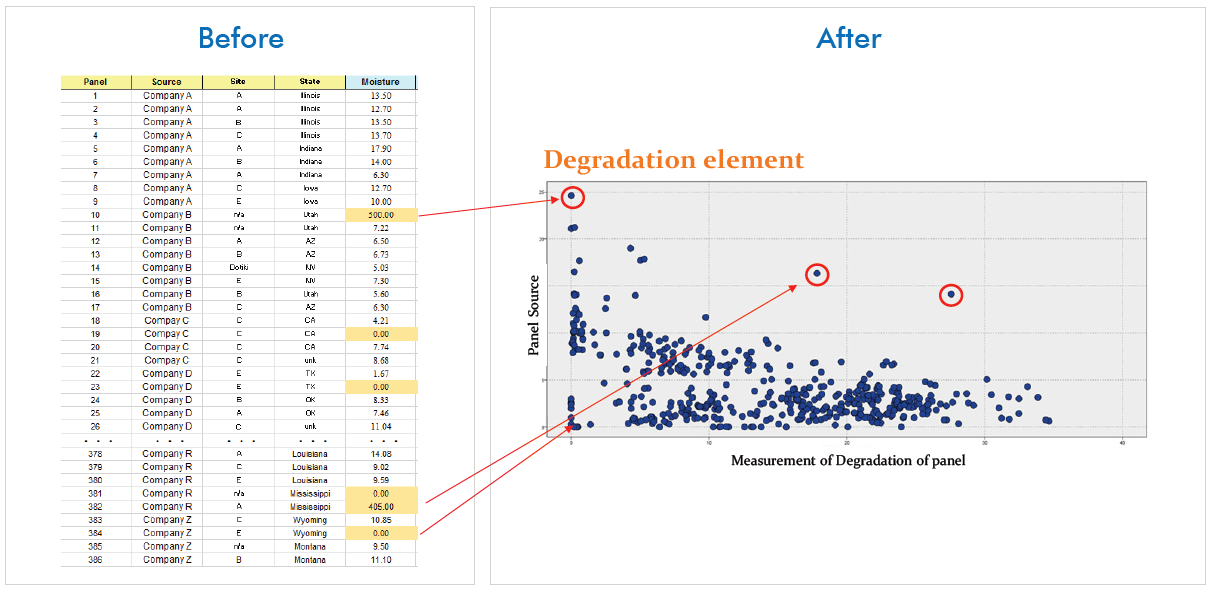
Objective
Your objective is to experiment with new ways to apply data visualization techniques to gain insights faster. When you can see patterns, you increase your understanding of the data. This may give you a headstart in planning how to improve the preparation and cleansing required to obtain meaningful results.
Below is an example of how data visualization is helpful in making it easier to understand and identify trends. This “After” view shows data for a solar corrosion analysis using box plots. Box plots provide a simple, intuitive way to show the overall range, median, and any outliers for each of the variables in the data.
The graph below displays aggregated totals for metadata, which is part of the Acquire stage. It shows areas where metadata fields are mostly complete (e.g., Dataset Name, Update Frequency) and fields where information is missing (e.g., Abstract, Key Words, Time Period, Purpose).
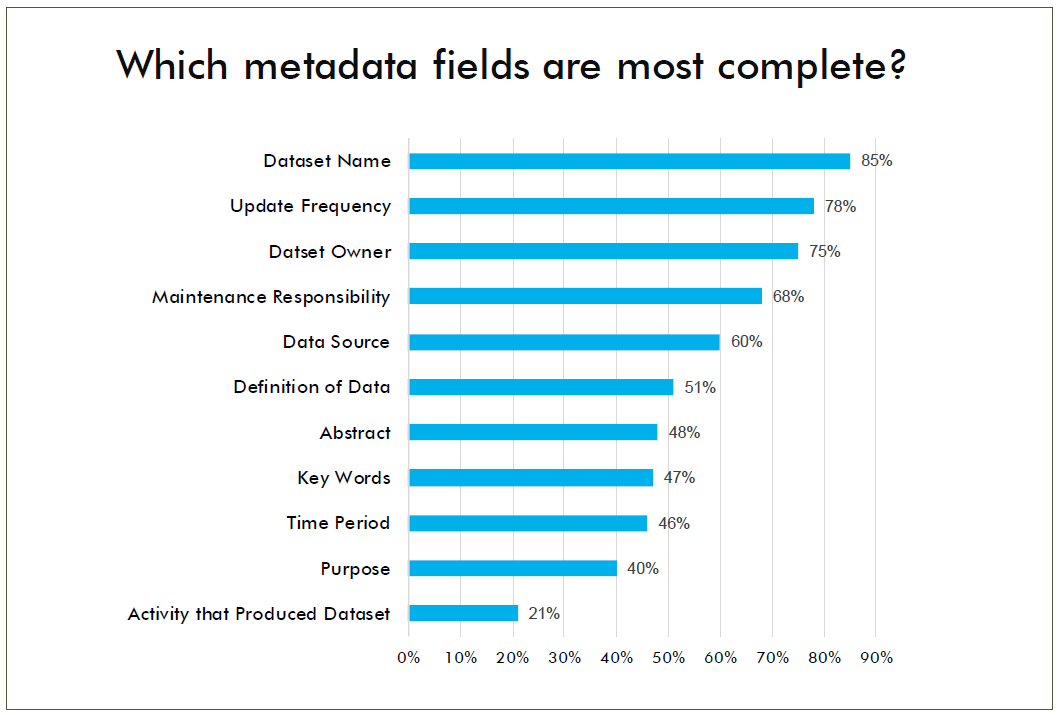
Quick Tips
- Expand your thinking about visualization. Explore classes, webinars, and online tutorials. New approaches and tools can help you present data in interesting ways.
- Begin by creating simple visual presentations of your data that clearly communicate key concepts, then branch out and experiment.
- Apply visualization at each stage of the Data Science Lifecycle to gain insights faster. The more you practice, the more comfortable you will become with the tools and techniques.
- Get ready to think differently about your data. Graphics are successful when data patterns and insights are easy to understand. This simplicity takes time and practice.

Key Insights
- Presenting data visually helps reduce complexity and facilitates seeing unique characteristics, such as patterns and outliers.
- Visuals help spark ideas about the data and help you and your stakeholders discover insights faster.
- Visualization tools enable you to enhance how you communicate insights by presenting data in multiple ways. These tools also expand the ways you can explore information.
Conclusion
Data visualization can expedite processes in the Acquire, Store, and Cleanse stages of the Data Science Lifecycle by displaying insights that help advance your work to the next stage. Using these techniques is a more efficient way to understand insights faster for informed decision making.
To help you select the right visualization software tools, below you can download sample business and technical requirements, and use a sample scorecard for evaluating solutions to best meet your needs.